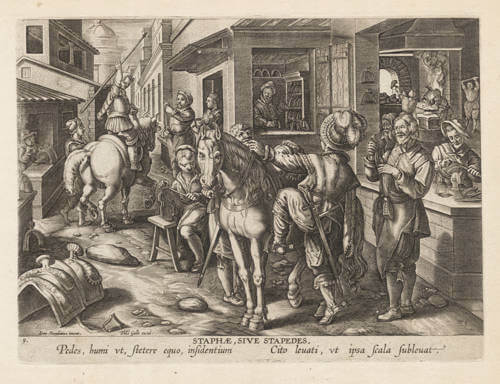Leen Helmink Antique Maps
Old books, maps and prints by Johannes Stradanus
Johannes Stradanus (1523-1605)
Johannes Stradanus, or Giovanni Stradano, or Jan van der Straet or van der Straat, or Stradanus or Stratensis (Bruges 1523 – Florence 2 November 1605) was a Flanders-born mannerist artist active mainly in 16th century Florence, Italy. Born in Bruges, he began his training in the shop of his father, then in Antwerp with Pieter Aertsen.
By 1545, he had joined the Antwerp guild of Saint Luke or painters' guild, the equivalent of the Roman (Accademia San Luca). He reached Florence in 1550, where he entered in the service of the Medici Dukes and Giorgio Vasari. The Medici court was his main patron, and he designed a number of scenes for tapestries and frescoes to decorate the Palazzo Vecchio in Florence, the Medici Villa at Poggio a Caiano, and providing illustrations for the Arazzeria Medicea. He also worked for the Pazzi Family in their estates in Montemurlo.
Many of his drawings became so popular they were translated into prints. Stradanus collaborated with printmakers Hieronymus Cock and the Galle family in Antwerp to produce hundreds of prints on a variety of subjects. He also worked with Francesco Salviati in the decoration of the Vatican Belvedere. He was one of the artists involved in the Studiolo of Francesco I (1567-1577), to which he contributed two paintings including "The Alchemist's Studio".
Karel van Mander wrote about Stradanus in his Schilder-boeck (book of famous painters), mentioning that he was 74 in 1603 and still a member of the Florence drawing academy. He also mentioned his pupil Antonio Tempesta, who painted ships and Amazon battle scenes (bataljes), mainly in 16th century Florence, Italy.
Johannes Stradanus is one of the most well-known unknown artists in history. Even though the Bruges-born painter (1523-1605) had a more than successful career in the highly competitive city of Florence in the second half of the 16th century, his name long remained a well-hidden secret for specialists only. Many of his works, though, are very well known.
Around 1570, Stradanus – who began as designer of tapestries and fresco painter in service of the Medici – started a second career as draughtsman and designer of hundreds of prints. These were engraved, published and distributed all over the then-known world by Antwerp publishers in huge numbers. It are these works – widely collected, copied and used – which secured Stradanus’s place in art history as an inventive and influential artist.
Johannes Stradanus died in Florence in 1605.
Literature
New Hollstein (Dutch and Flemish) 342-345 (Johannes Stradanus).
Stevens & Tooley: Map Collector 2, p.22-24, "One of the Rarest Picture Atlases".
van Mander: Schilder-boeck, 1604.
Sellink: Stradanus (1523-1605), Court Artist of the Medici, 2008.
Markey: Renaissance Invention - Stradanus's Nova Reperta, 2020.






















